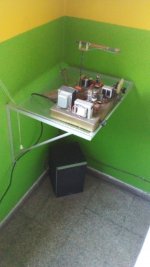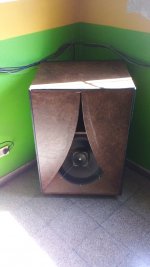Hey there,
if i would need to place my OB close to the wall (the subs are sealed so no problem with low hz) what would be the best way to do it?
Should i put them to the bare wall or should i put some diffusors/absorbers right behind it / next to it? If yes, which diffusor/absorber would be good?
Thanks
if i would need to place my OB close to the wall (the subs are sealed so no problem with low hz) what would be the best way to do it?
Should i put them to the bare wall or should i put some diffusors/absorbers right behind it / next to it? If yes, which diffusor/absorber would be good?
Thanks
Traditionally it was said that best place are in the corners at 45° from ea. So the floor and wall reflects sound and act like a horn. I learned it in books from the 70's and I still do it.
Attachments
Thanks but that placement is not possible. I just need to know, what would be better (theoretically), the frontwall naked or have some diffusors/absorbers on it? I guess that's a matter of testing and not just a simple answer
i have sealed subs, so i don't care about low (bass) freq.Diffusers or absorbers have no effect at low frequencies.
My problem is: i have a dip in 180-400hz and can't place the speakers far away from the walls. Now i wanted to try put them close to the wall, with the best result possible. That's why i ask
Try placement. Find a location that doesn't have as much of a problem with the dips. For higher frequencies than that, use absorption on that wall.
i have sealed subs, so i don't care about low (bass) freq.
My problem is: i have a dip in 180-400hz and can't place the speakers far away from the walls. Now i wanted to try put them close to the wall, with the best result possible. That's why i ask
I have to ask: how do you know or did you come to know that there is a "dip in the 180-400 Hz range"??? Did you measure that with a microphone, in the room? Also, what does your open baffle speaker look like, e.g. where are the drivers placed (how high above the floor).
The answers to these questions are very important and relevent, so please give as many details as you can. Can you supply a photo of the OB speaker, if you are comfortable with doing that?
Not necessarily...
Although one could say that any FAST or WAW type systems is "not designed well"! 😉
Let's see what Herr Geist has to say...
Although one could say that any FAST or WAW type systems is "not designed well"! 😉
Let's see what Herr Geist has to say...
OB do not belong next to a wall.Hey there,
if i would need to place my OB close to the wall (the subs are sealed so no problem with low hz) what would be the best way to do it?
Should i put them to the bare wall or should i put some diffusors/absorbers right behind it / next to it? If yes, which diffusor/absorber would be good?
Thanks
That's why you are experiencing dips at those frequencies.
The absolute closest to any wall I would place an OB is 1.5m, 2,+ being even better.
Adding absorbers do not really help, I tried.
If the design of your room or other limitations make it that you absolutely need to place the speakers on a wall, then consider changing your setup. On wall cabinets, like the Cornu, could work well.
Transmission lines also can benefit from getting a bit of a bass boost by being placed next to a wall.
IMO wide setting along the long wall of the room, speakers turned 30deg is best. At least 60cm(24") out from wall and even more out of corners.
Room response measurements are needed when testing various postion of speakers and the listener. But measurements are very ricky to do and interprete, lots of experience with different rooms and speakers is needed to avoid irrelevant "problems".
Room response measurements are needed when testing various postion of speakers and the listener. But measurements are very ricky to do and interprete, lots of experience with different rooms and speakers is needed to avoid irrelevant "problems".
I measured with a OMIK1 and REW. Here are the results (4 different placement options, near and far off the wall, green is the nearest to wall, that's why i asked the optimal way, if i would place it near the wall):I have to ask: how do you know or did you come to know that there is a "dip in the 180-400 Hz range"??? Did you measure that with a microphone, in the room? Also, what does your open baffle speaker look like, e.g. where are the drivers placed (how high above the floor).
The answers to these questions are very important and relevent, so please give as many details as you can. Can you supply a photo of the OB speaker, if you are comfortable with doing that?
OB's:
I know the placement is everything but optimal but even in a different room, 4ft away from frontwall, the measures are almost the same. The peaks in low bass is also a problem i'm battling right now. But the dips are what concern me the most. When i listen to music most songs sound perfect but some just have not enough "punch" to it.
I know this OB's very well, my father have these for years and one of my friends as well. They all have it relatively close to the wall and don't have the problem. So it's maybe my drivers who are faulty or something else..
I'm with the manufacturer in contact right now and hopefully he can help me with that.
I have tried having ob speakers near wall, and I found having a lot of padding behind, with an empty space of a few inche's immediately behind the baffle gave the least coloured sound.and still open sound. So baffle, space, padding, wall. I reasoned that having the baffles angled in would reduce any standing waves between the baffle and the wall, but I never investigated this fully.
You could take some measurements with the speakers well away from the wall (at the same height) to get an idea of which dips the wall is responsible for.
You could take some measurements with the speakers well away from the wall (at the same height) to get an idea of which dips the wall is responsible for.
like i said, i did a measure yesterday in a different room with the OB's in the middle of the room. The dip was still there (even though a little better). So i think it is a technical problem, rather than a room acoustic one. I'll do more measurements tonight
Perhaps that dip is a result of too much side cancellation.
Can you measure just ob without sub?
Maybe some wings facing back would extend to 100hz?
Can you measure just ob without sub?
Maybe some wings facing back would extend to 100hz?
Left + right solo and both together without subs:Perhaps that dip is a result of too much side cancellation.
Can you measure just ob without sub?
Maybe some wings facing back would extend to 100hz?
Wings would be interesting. Any idea how to do that?
I think the dip is the floor reflection. That is why you see it no matter the distance to the front wall, etc.
You can check by taking a couple of measurements at different elevations, keeping the elevation of the woofer center and microphone the same each time. As you move both towards the floor this dip should go away. In the measurement closest to the floor, just put the mic on the floor with the mic tip touching the floor. Do this on a flat hard surface.
If I am correct and it is the floor reflection, this dip MAY be audible but not necessarily. Your brain does not process sound in the same way a microphone measures the pressure at the diaphragm, and the brain will "ignore" many of the room reflections. This lowest frequency reflection, not as much, and sometimes it can cause the bass to seem a bit thin.
You can check by taking a couple of measurements at different elevations, keeping the elevation of the woofer center and microphone the same each time. As you move both towards the floor this dip should go away. In the measurement closest to the floor, just put the mic on the floor with the mic tip touching the floor. Do this on a flat hard surface.
If I am correct and it is the floor reflection, this dip MAY be audible but not necessarily. Your brain does not process sound in the same way a microphone measures the pressure at the diaphragm, and the brain will "ignore" many of the room reflections. This lowest frequency reflection, not as much, and sometimes it can cause the bass to seem a bit thin.
interesting, i'll try that and also gonna try a whole different room tonight. With carpet and symmetrical walls.I think the dip is the floor reflection. That is why you see it no matter the distance to the front wall, etc.
You can check by taking a couple of measurements at different elevations, keeping the elevation of the woofer center and microphone the same each time. As you move both towards the floor this dip should go away. In the measurement closest to the floor, just put the mic on the floor with the mic tip touching the floor. Do this on a flat hard surface.
If I am correct and it is the floor reflection, this dip MAY be audible but not necessarily. Your brain does not process sound in the same way a microphone measures the pressure at the diaphragm, and the brain will "ignore" many of the room reflections. This lowest frequency reflection, not as much, and sometimes it can cause the bass to seem a bit thin.
Thanks
My apologies, I did not read the previous post carefully enough.like i said, i did a measure yesterday in a different room with the OB's in the middle of the room. The dip was still there (even though a little better).
Your results seem to indicate, as you say, that the dips are not to do with the speaker/wall interaction.
In answer to your original question, I would experiment with listening to various permutations of absorbent in different places, and amounts.
Are you unhappy with how the speakers sound?
I'm not unhappy but i want to optimize. 8 out of 10 songs sound as i want it to. Now i want to go to 9 or 10 out of 10 (-:My apologies, I did not read the previous post carefully enough.
Your results seem to indicate, as you say, that the dips are not to do with the speaker/wall interaction.
In answer to your original question, I would experiment with listening to various permutations of absorbent in different places, and amounts.
Are you unhappy with how the speakers sound?
Do you have any recommendations for absorbent material? Maybe cheap to get, as i just want to test things out.
- Home
- Loudspeakers
- Full Range
- how to place open baffle (with sealed subs) close to wall?

